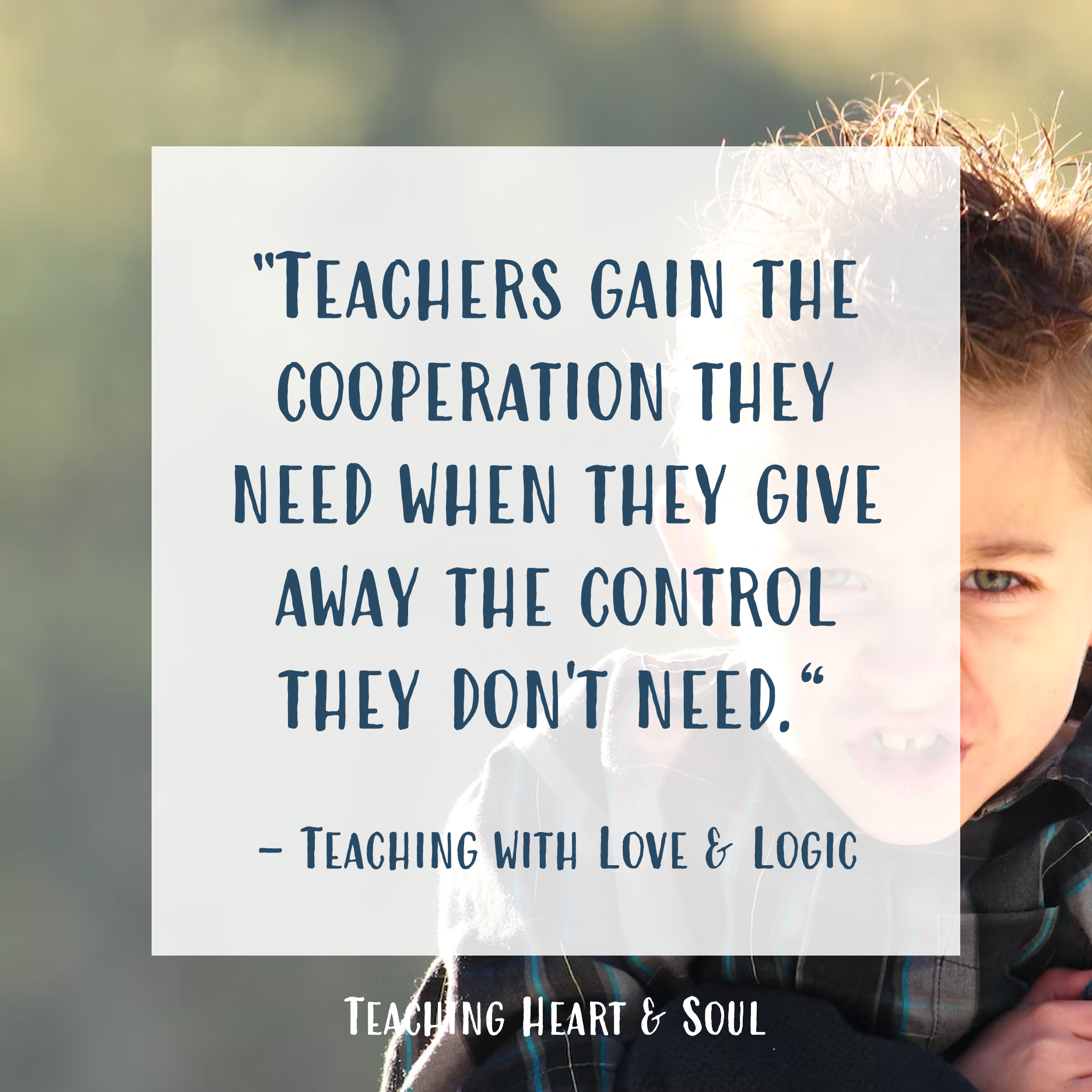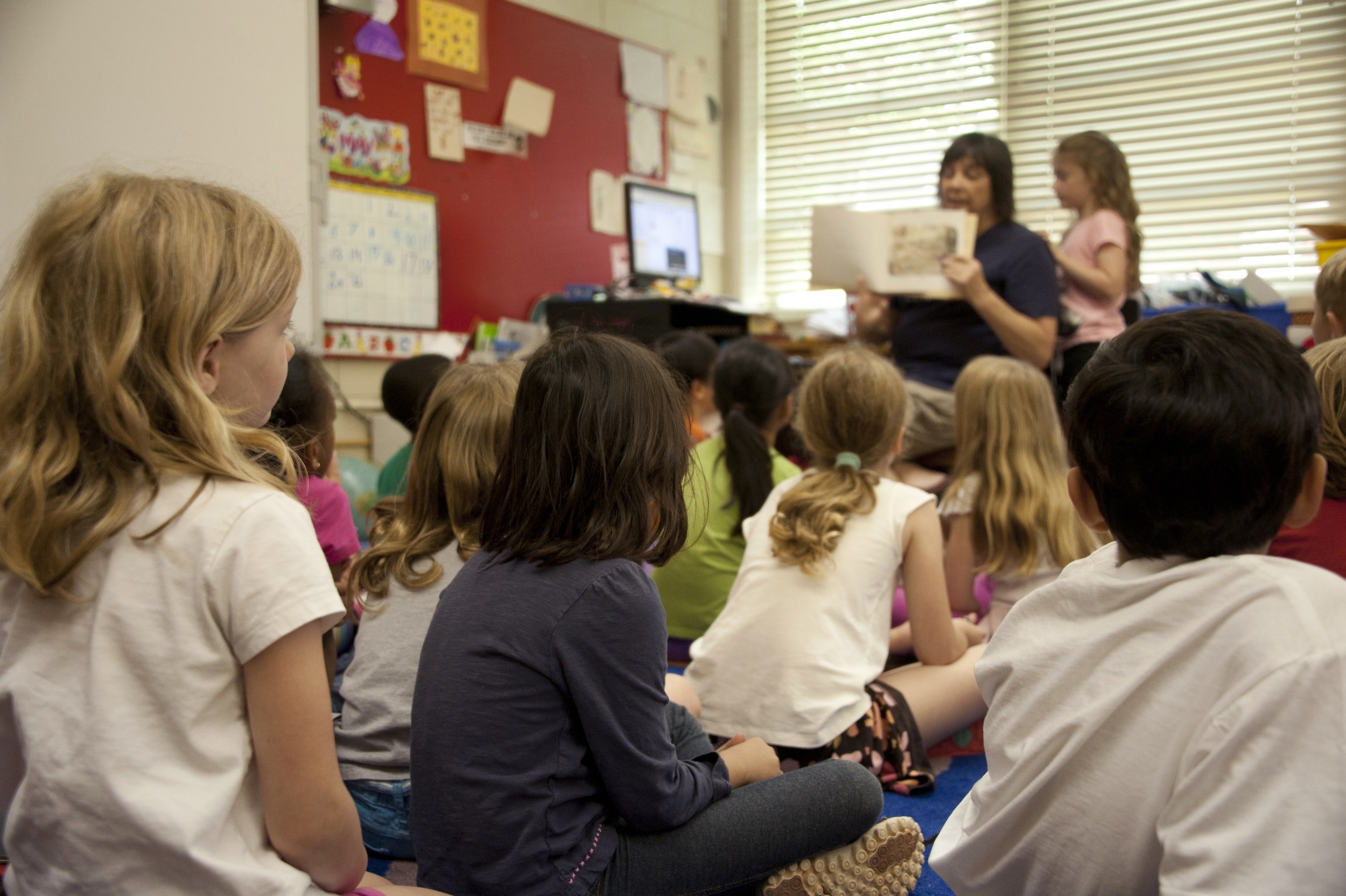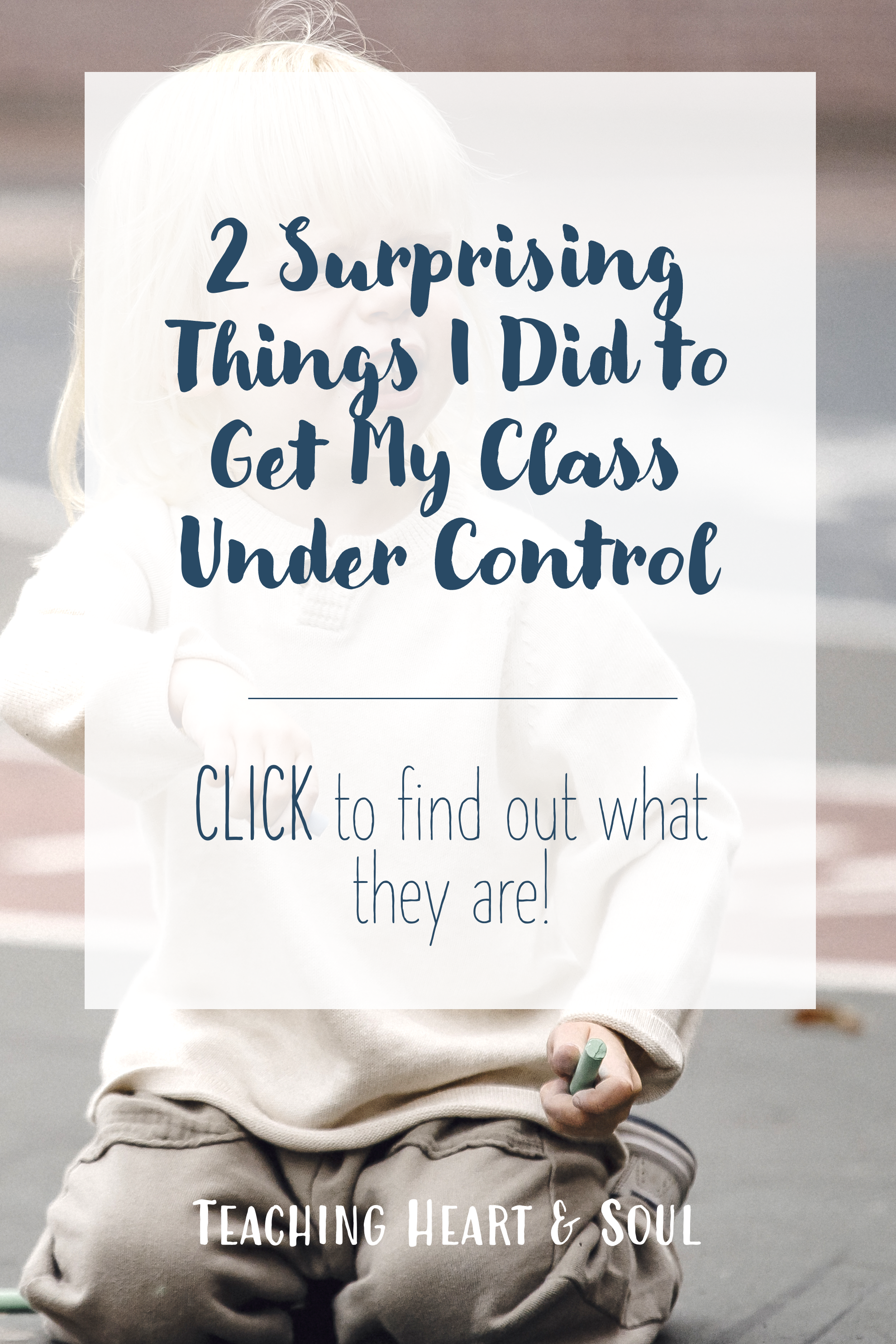The 2 Things I Did to Turn My Impossible Class Around
I had an impossible class of students my second year as a preschool teacher. The inappropriate behavior I saw in the classroom surprised me.
I was drowning, barely holding my head above water.
During this time, I learned 2 classroom management strategies that saved me and helped me turn my classroom around.
While I learned these classroom management strategies as a preschool teacher, these management strategies work in elementary school as well.
First-Year Teacher
My whole class was amazing when I was a first-year preschool teacher.
The students were well-behaved and almost the entire class came into my classroom ready for kindergarten. I coasted through that school year with hardly any classroom management strategy at all.
I knew I was blessed that year, and I expected the next year would be harder.
I had no idea how much harder my second year would be - and how much I would need a classroom management strategy that would work with my students.
I was unexperienced when it came to classroom management techniques and had no idea how important they were for a classroom environment.
Classroom Management
Classroom management is super important for creating a positive and productive learning environment. Classroom management strategies are all about making sure that students feel safe, engaged, and motivated to learn. Teachers do this by establishing clear classroom rules, routines, and procedures.
If you’d like a FREE eBook on effective classroom management strategies, CLICK HERE. Or, you can read a related blog post HERE.
Setting Expectations
When students understand what's expected of them and what's acceptable behavior in the classroom, they're more likely to stay focused and on-task.
By consistently enforcing these rules, teachers can help reduce disruptive behavior and create a sense of structure and consistency where students feel valued and respected.
Classroom Environment
Creating a positive culture in your classroom is all about building strong relationships with students and creating a sense of community within the classroom.
Teachers can do this by incorporating group activities and discussions, offering praise and encouragement for good behavior, and showing genuine interest in their students' lives.
By promoting a positive culture, teachers can help create a learning environment where students feel excited to come to class and eager to learn.
My Most Difficult Class
My second year as a preschool teacher started out terribly and only got worse.
I had a very challenging class and was overwhelmed by very challenging students.
I say "challenging" because it's polite, but that doesn't describe the outrageous behaviors I saw from a majority of my students.
My students hit each other, bit, screamed, threw themselves on the ground, threw furniture at students and teachers, climbed on top of furniture, and WOULD. NOT. LISTEN.
Classroom Difficulties
When I told a student to sit out during recess, he laughed and ran around the playground, daring me to chase him.
One student had a paraprofessional in the classroom with him at all times because his behavior was so out of control.
Another student climbed on the furniture to avoid napping.
Classroom Concerns
Some parents voiced their concerns that their child were not safe in the classroom.
I agreed, but I couldn't say it.
More than half of my students caused significant challenges for me.
Trying Everything
I tried every classroom management strategy I could think of at the time.
Collaboration
I worked with so many people that year, trying to figure out a classroom management strategy that would work - that would save my sanity!
The principal would come observe my classroom.
There were outside behavior specialists that worked with me and gave me suggestions.
I spoke to the veteran preschool teachers and asked for their help.
None of their suggestions were working.
Positive Reinforcement
Positive reinforcement has been very helpful in all of my other classrooms, so I don't want to give it a bad name here, but it did not work with this class.
I created a point system.
I stamped students' hands.
I implemented a coin system.
I gave out prizes from the prize box every day.
There was no improvement.
Consequences
I moved onto consequences.
I gave time-outs.
I threatened whatever I could think of.
I raised my voice.
This one hurt me. I never wanted to be that teacher.
Nothing worked. I did not feel like an effective teacher.
Coping
There were only a few things I could do that helped make teaching easier, but mostly by avoiding classroom management.
I ended circle time when I couldn't handle the chaos anymore.
I extended recess because there were less classroom rules outside than inside the classroom.
I let the disruptive and struggling students get their way sometimes.
Failure
As hard as I tried to get a handle on classroom management and create a positive classroom environment, nothing worked. I was angry with myself that I couldn't figure it out.
I felt like I was failing as a teacher.
If all the classroom management strategies I had put in place in my classroom weren't working, I would have to find a different classroom management plan.
Classroom Management Strategy 1: Engaging Lessons
One of the first things I tried that actually worked was to make the right choice as attractive as possible so that I could get my students engaged.
Up until this point, I was focusing so much on finding an effective classroom management system that focused on correcting poor behavior choices.
I spent all my energy on passing out coins or prize box and telling students to stop.
Stop fighting!
Stop hitting!
Stop running around!
As a consequence, many of my other students who may have enjoyed circle time and stayed engaged were not staying focused on my lesson.
They decided to join in on the "fun" of misbehaving instead because that's what got my attention. So, I started to ignore the misbehavior as much as possible.
Instead, I concentrated on getting students attention and making learning activities as fun and engaging as possible. I would encourage students to participate and get students excited.
It started to work.
Ignoring Unwanted Behavior
At times this meant allowing students to get away with things.
Climbing on Furniture
It meant ignoring a child who climbed on top of a bookcase while getting my students' attention on the activity I was doing.
I was afraid to try this because of the danger involved. On the other hand, I felt it was more dangerous to try to get the child to come down because she would make a game of it and try to run away.
Approaching her in the past was never helpful.
So, I ignored her and made circle time as engaging as possible, interacting with all of the students who were attending and giving attention to those with ideal behavior.
Getting off the Furniture
Once the girl saw that she wasn't getting any attention for her behavior, and that circle time looked pretty fun, she climbed off the bookcase on her own and joined us.
This strategy worked with a handful of my students.
When I ignored the kids who were acting up and concentrated on making activities interesting, my students started following classroom expectations.
This was enough to get a lot of my students on task. I only had a few students who were still very challenging.
Classroom Management Strategy 2: Giving Choices
The next strategy I used was to give my students choices.
At this point, a lot of my students were motivated to act appropriately because they wanted to be a part of what everyone else was doing.
They wanted to participate in circle time and small group activities because it was fun. They also knew that they weren't getting attention when they were out of line.
However, I still had quite a few children who didn't seem to care how entertaining I was trying to make things for them.
These kids continued to cause problems with their classmates and ignore teacher directions.
So I started giving them choices.
Examples
When a child was causing problems at the art center, I would say, "You may play with the building bricks or the race cars."
When a child was running around during circle time, I would say, "You may sit on the green square or next to me."
When a child was throwing rocks on the playground, I would say, "You may play nicely, or you may sit down on the bench."
Two Acceptable Choices
I learned this strategy from Love & Logic.
They say, "The art of giving effective choices: Always offer two options, either of which will make you deliriously happy."
In the examples I just gave, either option I gave the student was permissible. Sometimes both options were fun (e.g. building bricks and race cars). Other times, one of the options was more of a punishment (e.g. sit on the bench).
Either way, my students were given a choice. They felt like they were in control. sometimes the delusion of choice is enough for a young child. It gives the child enough power (real or perceived) that they do not feel the need to engage in a power struggle with the adult.
Focuses Attention
Giving a student two options also focuses their attention on what they can do. This is why teachers are supposed to tell students to "walk" rather than "stop running."
If you say "stop running," "stop hitting," or "stop talking," guess what the child is thinking about? -- running, hitting and talking!
Instead, tell a student what they can do.
When I gave my students choices, they didn't think about the fact that I was telling them what to do (or not to do!). They just thought about their options -- appropriate options -- and made a choice.
I stopped raising my voice in the classroom, telling my students to stop this or do that. Instead, I simply offered them two choices.
Enforceable Choices
For some of my students, two choices weren't enough. They wanted a third option -- to continue misbehaving. For these students, one of the choices I gave them had to be enforceable.
So I would say, "You may share the art supplies, or you may be done with art center." If the child still wouldn't share or walk away from the center, I would remove the art supplies from that student. I would make the choice for that student.
Some of my students would respond with a tantrum (which I would ignore as I continued making class time engaging).
Over time, students realized that they didn't get any attention for their tantrums and that they missed out on all the fun when they threw a fit. So, their tantrums grew shorter and less often.
Examples of Giving Choices
Sometimes it feels frustrating that our class of 7-year-olds won't listen to us. We're the teacher. We're the adult. We know best. Right?
But, as much as that may be the case, children really respond to being in control.
Teaching with Love and Logic says, "Teachers gain the cooperation they need when they give away the control they don't need."
Here are some examples of how to give choices:
Would you like to work on your math homework or your spelling homework first?
Would you like to play foursquare nicely or would you like to watch?
Do you want to sit on the floor with us or at your desk?
Would you like to work by yourself or with your classmates?
You can either use a quiet voice like mine or you can ask me again later.
You may use a pencil or a pen.
Which center would you like to start with? X, y, or Z?
Would you prefer to correct your work or have me do it?
You can take the test during class time or stay in from recess and do it.
Enforceable Statements
A related classroom management strategy to use with disruptive and struggling students is to use enforceable statements. This can also feel like a choice to students, but it sounds a little different from the examples above. You're probably familiar with the idea already, even if you haven't heard the term before.
Examples of Enforceable Statements:
I will start reading when everyone is quiet.
I will call on students who are raising their hands.
Students who wait their turn get a prize.
I will dismiss for recess when all the trash is picked up.
We can start our game when everyone is following directions.
We'll start when you're all sitting down.
I will dismiss students who have finished cleaning up.
You can go out as soon as you have your lunchbox in hand.
In the End
After implementing these two strategies, my classroom was not perfect, but it was manageable. My stress level went down.
Many of the students that were exasperating me before started to grow on me. I started to enjoy my time with them.
Once I made my class as engaging as I could and gave my students choices, most of my classroom management problems disappeared. My impossible class had turned around, and I started to enjoy teaching again.
That's not to say that these classroom management strategies resulted in positive behavior 100% of the time. But the classroom behavior overall improved, I got students engaged, and the negative feelings I had been having every day when coming to work dissipated.
Importance of Classroom Management
Successful classroom management is crucial.
Classroom management strategies and techniques can help teachers establish clear expectations for behavior and create a sense of structure and consistency in the classroom.
By implementing a classroom management plan, teachers can promote positive behavior and create a culture of respect and responsibility among their students.
There are many universal classroom management strategies that have been proven to be effective, such as establishing clear classroom rules and routines, creating a positive classroom culture, and encouraging good behavior.
For me, the two strategies that worked the best in my most difficult class was getting students engaged by making learning fun and offering choices to students.
Find What Works for You
Teachers can also explore a variety of classroom management ideas to find the best strategies that work for their specific classroom and teaching style.
As I said before, encouraging positive behavior works for me most of the time, but it wasn't the most important thing in this case. So, find what works for you.
The best classroom management strategies are the ones that are tailored to the specific needs of the students and the classroom environment.
By consistently implementing these strategies, teachers can help create a learning environment where students feel safe, engaged, and motivated to learn.
Make a Plan
So, take the time to develop a classroom management plan that works for you and your students, and don't be afraid to try out new ideas and techniques. With the right approach, you can create a classroom where students learn and everyone can thrive and achieve their full potential.
















